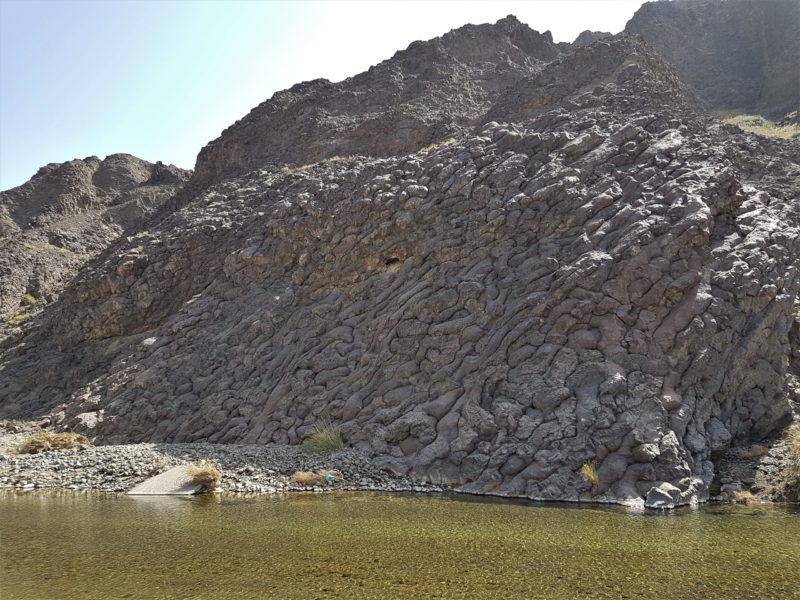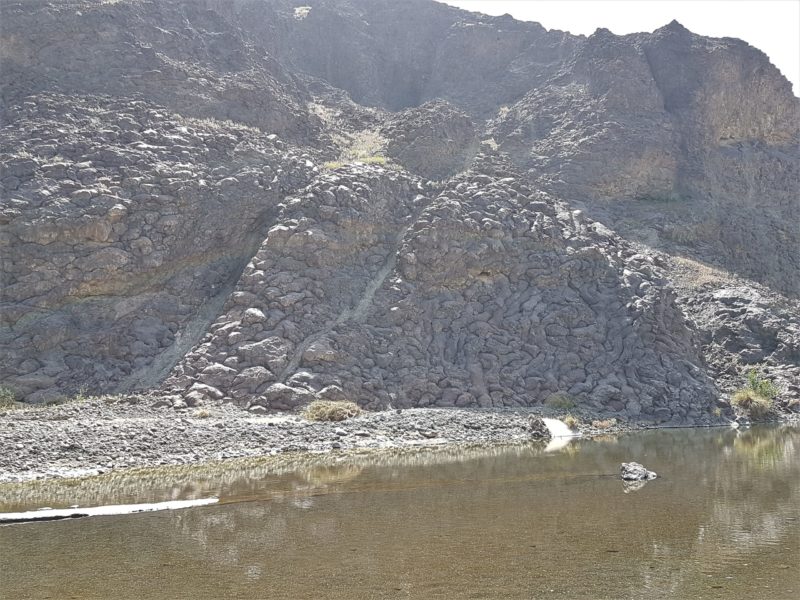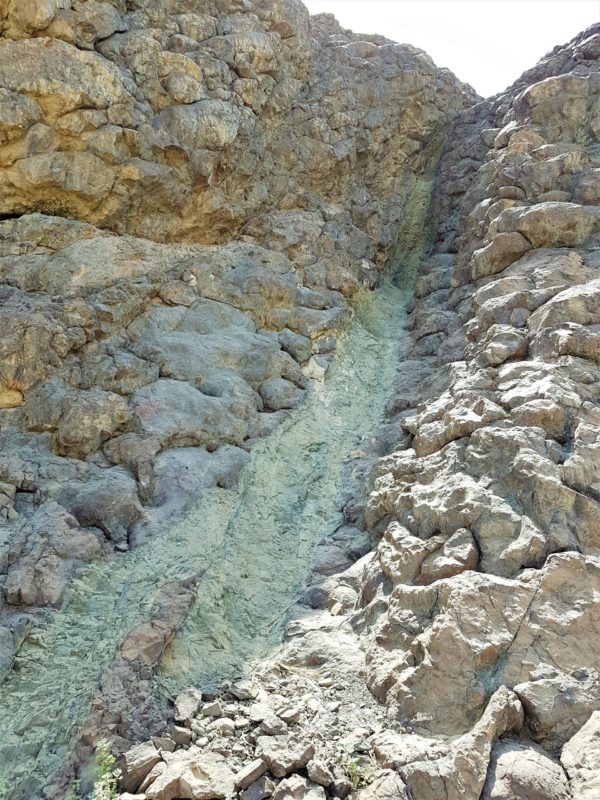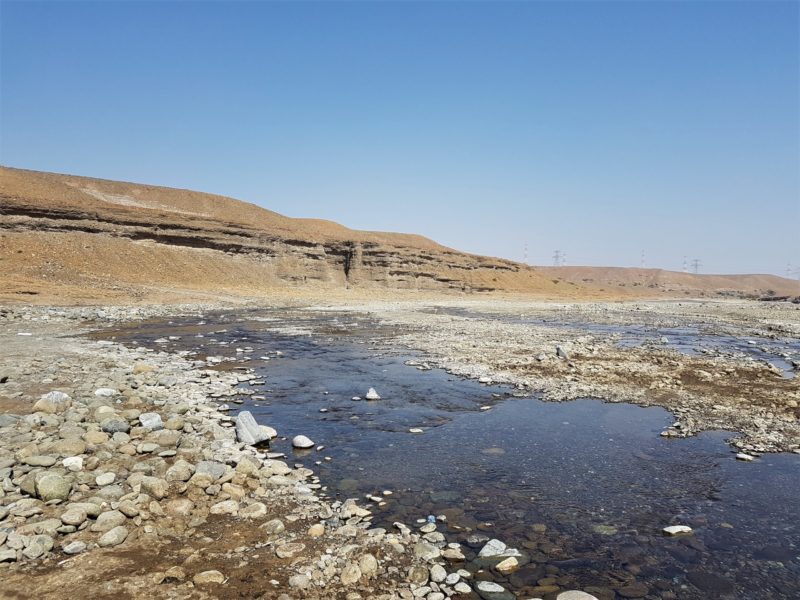5 March 2020
A geological detour: the Geotimes pillow lavas at Wadi Jizzi in Oman
Posted by Dave Petley
A geological detour: the Geotimes pillow lavas at Wadi Jizzi in Oman
Earlier this week I made a brief trip to Oman as part of my (non-geological) day job, in this case attending the opening ceremony of Intaj Suhar, the Oman equivalent of the wonderful University of Sheffield Advanced Manufacturing Research Centre, which sits within my portfolio. On Sunday I took a detour inland to visit the famous Geotimes pillow lavas at Wadi Jizzi, about 30 km inland from the city of Sohar.
These rock are famous as they appeared on the front cover of the Geotimes Magazine in 1975 (the magazine is now known as Earth Magazine). I visited courtesy of a somewhat bemused taxi driver, who clearly could not really understand why I’d drive out into the desert to look at rocks. However, these are truly spectacular:-

The pillow lavas of Wadi Jizzi in Oman.
.
Cutting across the outcrop are two well exposed altered basalt dikes:-

The two basalt dikes that cross-cut the Geotimes pillow lavas in Oman.
.
These altered dikes seem to be much more susceptible to weathering, so form distinctive gullies within the outcrop:-

An altered dike in the Geotimes pillow lavas at Wadi Jizzi in Oman.
.
These pillow lavas were formed within the Semail Ophiolite at the bottom of the Tethys Ocean. The William and Mary Blog has a nice explanation as to how they formed:-
“Pillows commonly form when lava is extruded under water. As lava disgorges from its vent on the sea floor it comes in contact with the surrounding seawater that rapidly quenches the lava to a glassy solid, thereby partially clogging the conduit and forcing to lava to ooze out nearby. This repetitive process of extrusion and rapid quenching produces the tube to pillow-like morphology.”
These pillow lavas are exceptionally well-preserved. The explanation for this might lie in the deposits on the other side of the valley:-

Alluvial deposits that might have preserved the pillow lavas at Wadi Jizzi.
.
I suspect that these alluvial deposits might have covered the pillow lavas until recently, preserving them.
Pillow lavas are very hard, and the interlocking structure will give the rock mass considerable strength. As a consequence they are likely to be resistant to failure, and thus not a good place to go looking for landslides.
The Habits of a Travelling Archaeologist blog has a good guide to visiting the site.


 Dave Petley is the Vice-Chancellor of the University of Hull in the United Kingdom. His blog provides commentary and analysis of landslide events occurring worldwide, including the landslides themselves, latest research, and conferences and meetings.
Dave Petley is the Vice-Chancellor of the University of Hull in the United Kingdom. His blog provides commentary and analysis of landslide events occurring worldwide, including the landslides themselves, latest research, and conferences and meetings.
Thank you for this valuable insight
…taking the time, energy, & expense for taking the side trip into the desert.Thank you.
Does the seawater contact also explain the “pillow” forms’ resistance to erosion? It made me think of the Roman concrete remains at Ostia, which have endured many centuries: this is attributed to the effect of sea water on the volcanic materials in the aggregate.
Here’s a link to the Geological Society of Oman field guide to Wadi Jizzi:
https://sites.google.com/site/liljanschreurs/Home/wadi-jizzi-geological-excursion
The whole area also has some great archaeology linked to the copper mines dated back to 3000-4000 years ago.
There’s plenty of other sites in Oman where you can see pillow lavas, but not on this scale. There’s also the opportunity to go and stand on the Moho. 🙂
Hi Dave,
First time I have looked at Wadi Jizzi since 1989 when involved in the construction of the “leaky” earth fill dam’. Just a quick question, but did you visit the dam, or from a geological aspect (I graduated in 1974 in geology), the Magan copper mine? A visit, down the mine, is worth it, if you’re in the area, and the staff we’re always very accommodating.
Kind regards
Bill Siviter
Hi Dave,
First time I have looked at Wadi Jizzi since 1989 when involved in the construction of the “leaky” earth fill dam’. Just a quick question, but did you visit the dam, or from a geological aspect (I graduated in 1974 in geology), the Magan copper mine? A visit, down the mine, is worth it, if you’re in the area, and the staff we’re always very accommodating.
Kind regards